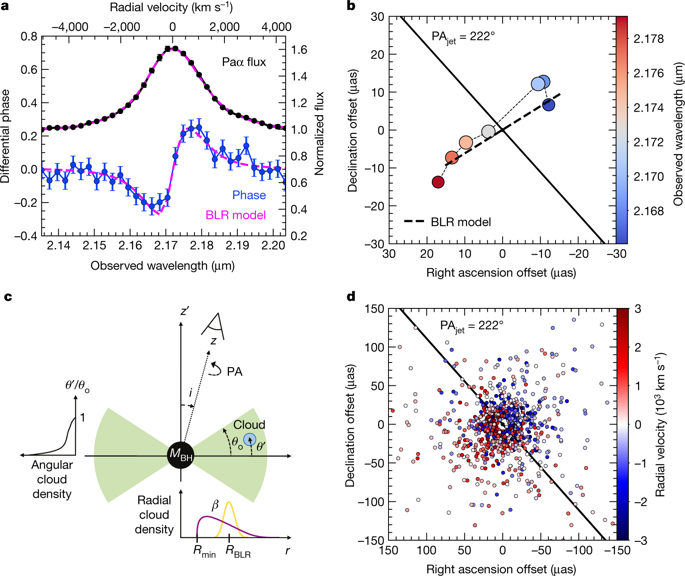Our official English website, www.x-mol.net, welcomes your
feedback! (Note: you will need to create a separate account there.)
Spatially resolved rotation of the broad-line region of a quasar at sub-parsec scale
Nature ( IF 50.5 ) Pub Date : 2018-11-01 , DOI: 10.1038/s41586-018-0731-9
Nature ( IF 50.5 ) Pub Date : 2018-11-01 , DOI: 10.1038/s41586-018-0731-9

|
The broadening of atomic emission lines by high-velocity motion of gas near accreting supermassive black holes is an observational hallmark of quasars1. Observations of broad emission lines could potentially constrain the mechanism for transporting gas inwards through accretion disks or outwards through winds2. The size of regions for which broad emission lines are observed (broad-line regions) has been estimated by measuring the delay in light travel time between the variable brightness of the accretion disk continuum and the emission lines3—a method known as reverberation mapping. In some models the emission lines arise from a continuous outflow4, whereas in others they arise from orbiting gas clouds5. Directly imaging such regions has not hitherto been possible because of their small angular size (less than 10−4 arcseconds3,6). Here we report a spatial offset (with a spatial resolution of 10−5 arcseconds, or about 0.03 parsecs for a distance of 550 million parsecs) between the red and blue photo-centres of the broad Paschen-α line of the quasar 3C 273 perpendicular to the direction of its radio jet. This spatial offset corresponds to a gradient in the velocity of the gas and thus implies that the gas is orbiting the central supermassive black hole. The data are well fitted by a broad-line-region model of a thick disk of gravitationally bound material orbiting a black hole of 3 × 108 solar masses. We infer a disk radius of 150 light days; a radius of 100–400 light days was found previously using reverberation mapping7–9. The rotation axis of the disk aligns in inclination and position angle with the radio jet. Our results support the methods that are often used to estimate the masses of accreting supermassive black holes and to study their evolution over cosmic time. High-angular-resolution observations of the quasar 3C 273 reveal that it has a relatively small but thick disk, viewed nearly face-on, in which material is orbiting the central supermassive black hole.
中文翻译:

类星体宽线区域在亚秒差距尺度上的空间分辨旋转
吸积超大质量黑洞附近气体的高速运动使原子发射线变宽是类星体的一个观测标志。对宽发射线的观测可能会限制气体通过吸积盘向内输送或通过风向外输送的机制。观测到宽发射线的区域(宽线区域)的大小是通过测量吸积盘连续体的可变亮度与发射线之间的光传播时间延迟来估计的,这种方法称为混响映射。在一些模型中,发射线来自连续流出 4,而在其他模型中,它们来自轨道气体云 5。由于这些区域的角尺寸小(小于 10-4 弧秒 3,6),迄今为止无法直接对这些区域进行成像。在这里,我们报告了类星体 3C 273 的宽帕申-α 线的红色和蓝色光心之间的空间偏移(空间分辨率为 10-5 弧秒,或约 0.03 秒差距,距离为 5.5 亿秒差距)到它的无线电射流的方向。这种空间偏移对应于气体速度的梯度,因此暗示气体正在围绕中心超大质量黑洞运行。这些数据与围绕一个 3 × 108 太阳质量的黑洞运行的重力束缚物质厚圆盘的宽线区域模型拟合得很好。我们推断圆盘半径为 150 光日;之前使用混响映射 7-9 发现了 100-400 光日的半径。圆盘的旋转轴与无线电射流在倾斜和位置角度上对齐。我们的结果支持常用于估计吸积超大质量黑洞质量和研究它们在宇宙时间内演化的方法。对类星体 3C 273 的高角分辨率观测表明,它有一个相对较小但较厚的圆盘,几乎正面看,其中物质围绕中央超大质量黑洞运行。
更新日期:2018-11-01
中文翻译:

类星体宽线区域在亚秒差距尺度上的空间分辨旋转
吸积超大质量黑洞附近气体的高速运动使原子发射线变宽是类星体的一个观测标志。对宽发射线的观测可能会限制气体通过吸积盘向内输送或通过风向外输送的机制。观测到宽发射线的区域(宽线区域)的大小是通过测量吸积盘连续体的可变亮度与发射线之间的光传播时间延迟来估计的,这种方法称为混响映射。在一些模型中,发射线来自连续流出 4,而在其他模型中,它们来自轨道气体云 5。由于这些区域的角尺寸小(小于 10-4 弧秒 3,6),迄今为止无法直接对这些区域进行成像。在这里,我们报告了类星体 3C 273 的宽帕申-α 线的红色和蓝色光心之间的空间偏移(空间分辨率为 10-5 弧秒,或约 0.03 秒差距,距离为 5.5 亿秒差距)到它的无线电射流的方向。这种空间偏移对应于气体速度的梯度,因此暗示气体正在围绕中心超大质量黑洞运行。这些数据与围绕一个 3 × 108 太阳质量的黑洞运行的重力束缚物质厚圆盘的宽线区域模型拟合得很好。我们推断圆盘半径为 150 光日;之前使用混响映射 7-9 发现了 100-400 光日的半径。圆盘的旋转轴与无线电射流在倾斜和位置角度上对齐。我们的结果支持常用于估计吸积超大质量黑洞质量和研究它们在宇宙时间内演化的方法。对类星体 3C 273 的高角分辨率观测表明,它有一个相对较小但较厚的圆盘,几乎正面看,其中物质围绕中央超大质量黑洞运行。











































 京公网安备 11010802027423号
京公网安备 11010802027423号